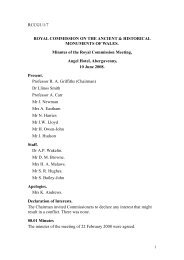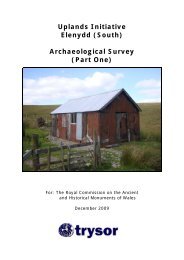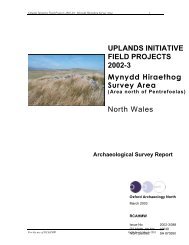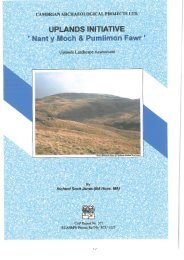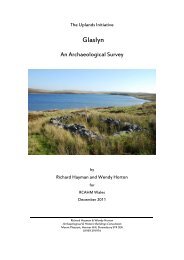Mynydd Llangynidr, Brecknockshire - Royal Commission on the ...
Mynydd Llangynidr, Brecknockshire - Royal Commission on the ...
Mynydd Llangynidr, Brecknockshire - Royal Commission on the ...
You also want an ePaper? Increase the reach of your titles
YUMPU automatically turns print PDFs into web optimized ePapers that Google loves.
<str<strong>on</strong>g>Mynydd</str<strong>on</strong>g> <str<strong>on</strong>g>Llangynidr</str<strong>on</strong>g> Upland Survey<br />
UIP081 Report Versi<strong>on</strong>: Final<br />
Produced for RCAHMW<br />
Tracks<br />
5.8 The vast majority of <strong>the</strong> tracks found were fairly modern and provided access to <strong>the</strong> quarries.<br />
O<strong>the</strong>r tracks were caused by modern agricultural activity and walkers’ access to local attracti<strong>on</strong>s<br />
such as <strong>the</strong> Chartist’s Cave at <strong>the</strong> centre of <str<strong>on</strong>g>Mynydd</str<strong>on</strong>g> <str<strong>on</strong>g>Llangynidr</str<strong>on</strong>g>. These were not recorded as <strong>the</strong>y<br />
were usually too modern to warrant a specific record. Many tracks are heavily obscured by<br />
vegetati<strong>on</strong> and <strong>the</strong>re were a variety of forms. Some were revetted with st<strong>on</strong>e walling ei<strong>the</strong>r<br />
downslope or upslope, some were simple ledges cut into <strong>the</strong> hillside or embanked up<strong>on</strong> it, and<br />
many were hollow ways. Of <strong>the</strong> latter many were faint depressi<strong>on</strong>s, but some were impressive<br />
cuttings as at SO 19197 24939, where <strong>the</strong> trackway is roughly 2 metres deep and 3 metres wide<br />
at <strong>the</strong> top of <strong>the</strong> hollow. A few tracks, particularly al<strong>on</strong>g <strong>the</strong> tops of <strong>the</strong> ridges, are still used by<br />
walkers due to <strong>the</strong> views, and for <strong>the</strong> same reas<strong>on</strong> may date back thousands of years. These<br />
tracks are usually simple worn paths ranging for kilometres and are frequently marked with<br />
cairns.<br />
Sheepfolds<br />
5.9 Sheepfolds were scattered throughout <strong>the</strong> area, varying markedly in size and shape. A<br />
complex <strong>on</strong>e including a 50 metre l<strong>on</strong>g central cell with four o<strong>the</strong>r cells inside was located at SO<br />
09667 011984. The amount and quality of c<strong>on</strong>structi<strong>on</strong> suggests it was <strong>on</strong>ce an element of a<br />
centralised system of sheep management with perhaps several owners sharing <strong>the</strong> resource.<br />
Recreati<strong>on</strong>al and clearance cairns<br />
5.10 Most of <strong>the</strong> cairns recorded were associated with trackways, and probably date to <strong>the</strong> post<br />
medieval period. Several of <strong>the</strong> summits in <strong>the</strong> area had piles of st<strong>on</strong>es made by modern day<br />
walkers. Recreati<strong>on</strong>al cairns were also found within defunct quarries where <strong>the</strong>re was plentiful<br />
waste material and around collapsed walls. The distributi<strong>on</strong> of recreati<strong>on</strong>al cairns <strong>the</strong>refore<br />
correlates with <strong>the</strong> distributi<strong>on</strong> of natural or reusable material. The <strong>on</strong>ly clearance cairns found<br />
during <strong>the</strong> survey were particularly large and near <strong>the</strong> improved fields in <strong>the</strong> south-western corner<br />
of <strong>the</strong> study area, <strong>on</strong> <strong>the</strong> edge of P<strong>on</strong>tsticill reservoir. These clearance cairns probably date to<br />
between <strong>the</strong> post-medieval period to modern day and may have been created mechanically. The<br />
CPAT HER had many of <strong>the</strong>se clearance cairns attributed to prehistoric activity in <strong>the</strong> area of<br />
Waun Rydd valley.<br />
Shooting butts<br />
5.11 Shooting butts were most comm<strong>on</strong>ly found <strong>on</strong> <strong>the</strong> eastern side of <str<strong>on</strong>g>Mynydd</str<strong>on</strong>g> <str<strong>on</strong>g>Llangynidr</str<strong>on</strong>g>, as<br />
<strong>the</strong>re is copious amounts of outcropping rock out of which to c<strong>on</strong>struct <strong>the</strong> butts. These varied in<br />
form between simple hollows in <strong>the</strong> scree slopes, single curved walls and complete circles. They<br />
face all directi<strong>on</strong>s, but usually with a good view of <strong>the</strong> heath.<br />
The correlati<strong>on</strong> of air photo transcripti<strong>on</strong>s to sites<br />
5.12 Elements that correlated well were quarries, some structures and most of <strong>the</strong> field<br />
boundaries, some of <strong>the</strong>se also correlating with field boundaries noted <strong>on</strong> 1st editi<strong>on</strong> OS mapping.<br />
The record was augmented by c<strong>on</strong>structi<strong>on</strong> details and identificati<strong>on</strong> of fur<strong>the</strong>r structural units.<br />
More ephemeral features like possible cultivati<strong>on</strong> or larger enclosures proved difficult to c<strong>on</strong>firm<br />
<strong>on</strong> <strong>the</strong> ground.<br />
Page 13<br />
\\Harappa\projects\UIP081 <str<strong>on</strong>g>Mynydd</str<strong>on</strong>g> <str<strong>on</strong>g>Llangynidr</str<strong>on</strong>g>\Reporting\Draft Final\AP UIP081 <str<strong>on</strong>g>Mynydd</str<strong>on</strong>g> <str<strong>on</strong>g>Llangynidr</str<strong>on</strong>g> report<br />
(Draft Final).doc<br />
Copyright ArchaeoPhysica Ltd. 10/02/2009




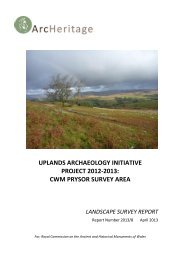
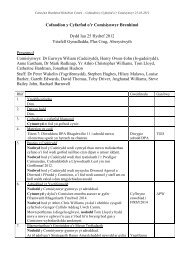
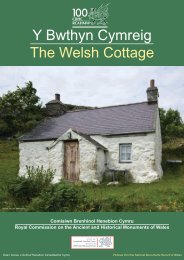

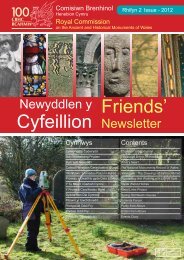
![The Source of the Usk Walk [2012 PDF]](https://img.yumpu.com/49285699/1/190x245/the-source-of-the-usk-walk-2012-pdf.jpg?quality=85)


